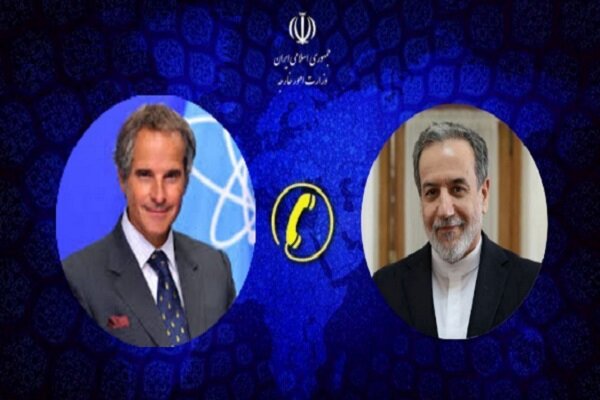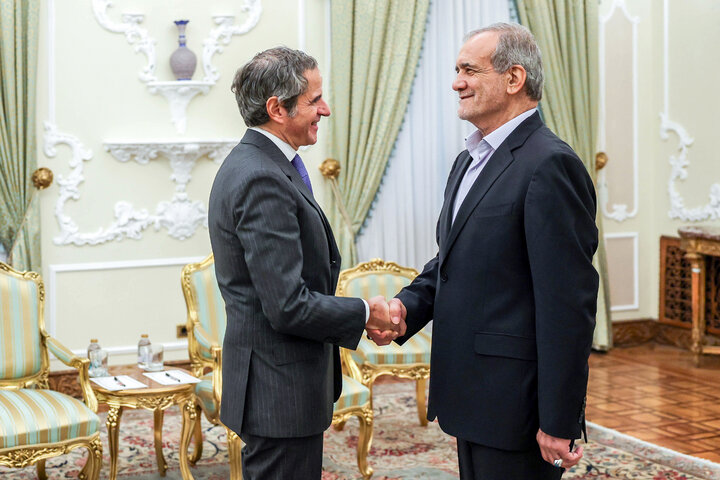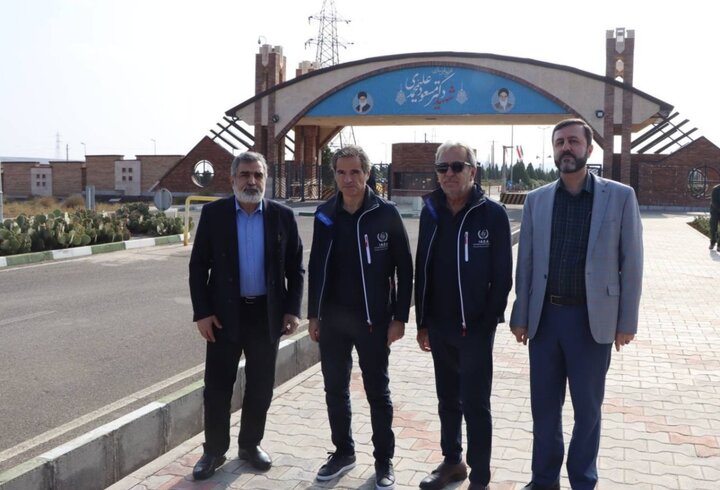The visit of the Director General of the International Atomic Energy Agency to Tehran before the start of the second round of indirect talks between Iran and the United States, in addition to the technical aspects, demonstrates Iran's goodwill and determination on the path of nuclear diplomacy.
According to Ashura News, citing Mehr News Agency, on the eve of the second round of indirect talks between the Islamic Republic of Iran and the United States, the visit of Rafael Grossi, Director General of the International Atomic Energy Agency, to Tehran is not only a technical measure, but also a deliberate and multi-layered move by Iran that contains important messages.
Rafael Grossi, Director General of the International Atomic Energy Agency, discussed the latest status of cooperation between Iran and the Agency in a telephone call on April 1 with Seyyed Abbas Araqchi, Minister of Foreign Affairs of our country.
Referring to Iran's policy for interaction and cooperation with the Agency, Araqchi stated that the International Atomic Energy Agency must adopt a clear position regarding threats against the peaceful nuclear facilities of the Islamic Republic of Iran. He emphasized that given the continuation of these threats, the Islamic Republic of Iran will take any necessary measures to protect its nuclear program.
The Director General of the International Atomic Energy Agency also said: "He will hold consultations with other parties to create a suitable atmosphere to help resolve existing issues."
In this context, he proposed a request to visit Iran, which was approved in principle by our country's Foreign Minister. It was decided that in order to ensure the success of this visit, the details of the matter would be reviewed and finalized between the two parties through appropriate channels.

The principled acceptance of this visit, at this sensitive time, is a clear sign of Iran’s goodwill and desire to maintain the path of dialogue and reduce tensions. In a situation where some are trying to pollute the upcoming atmosphere with doubts, pressure and political narratives, this visit is seen as a kind of intelligent adjustment of the diplomatic scene before the official start of the negotiations.
Grossi last visited Tehran in November 1402 and met with Masoud Pezzekian, President of the Islamic Republic of Iran, Seyyed Abbas Araqchi, Foreign Minister, and Mohammad Eslami, Head of the Atomic Energy Organization of Iran.

He also visited the Natanz and Fordow enrichment facilities for the first time.

During Grossi's previous visit to our country, Iran proposed that in order to end the inspector issue, despite the fact that the cancellation of the appointment of the previous inspectors based on Article 9 of the Safeguards Agreement was an indisputable sovereign right of Iran, four new inspectors (two German and two French), of course, other than the previously canceled inspectors, be introduced to Iran by the Agency to review the appointment. Grossi, who was highly confident in the feasibility of his idea and initiative, left Tehran at the end of his two-day visit with the feeling and confidence that he would return to Vienna with his hands full to create an interactive atmosphere, but this issue still could not prevent the political activities of European and American countries.
After the visit of Rafael Grossi, Director General of the International Atomic Energy Agency, to Iran and his visit to the Natanz and Fordow nuclear sites and some advanced parts of the nuclear industry, the Board of Governors, as the upper body of the Agency, issued a resolution against our country under pressure from some Western countries.
In the final hours of the meeting on December 1, 1403, the Board of Governors of the International Atomic Energy Agency, under pressure and insistence from three European countries and the United States, and despite the lack of support from about half of the member states, passed a non-unanimous resolution with 19 votes in favor, 3 against, and 12 abstentions on Iran’s peaceful nuclear program.
Iran’s response to the resolution
After issuing this resolution, the head of the Atomic Energy Organization of Iran issued an order to take effective measures, including launching a significant set of new and advanced centrifuges of various types.
“Varamin and Turqoozabad”; Rejection of the Agency’s claims about Iran’s nuclear sites
Following the claims made by the International Atomic Energy Agency regarding the existence of nuclear activities at the two sites of “Varamin” and “Turqoozabad”, the Islamic Republic of Iran considers these claims to be baseless and lacking valid documentation and has given documented and clear responses to these issues.
Iran has repeatedly explained to the Agency that there are no undeclared locations as required by the Comprehensive Safeguards Agreement (CSA). Regarding the claim of a “pilot-scale factory” between 1999 and 2003, Tehran has stated that this claim lacks credible documentation and reliable information and believes that the provision of such evidence by the Zionist regime is malicious. The Agency should not pay attention to such fabricated documents.
Regarding the Varamin location, the Agency has only referred to poor-quality satellite images that claim that “containers have been moved from Varamin to Turqoozabad.” Iran considers these images unreliable and believes that the movement of thousands of similar containers across the country cannot alone be evidence to substantiate such a claim.
Iran has also stressed in response to the Agency’s claims about “Turqoozabad” that the Agency’s assessments were not based on credible and documented information. Turqoozabad is an industrial area that includes warehouses and storage facilities for various materials, including detergents, chemicals, textiles, and automobile parts. Iran has stated that the movement of containers at this location is a normal and daily activity in that industrial area and cannot be considered conclusive evidence for any nuclear claim.
Tehran has stated in negotiations with the Agency that in the investigations conducted into the history of activities carried out at Turqoozabad, apart from the possibility of sabotage, there is no scientific or logical reason for the presence of uranium particles at this location. This explanation clearly shows that Iran rejects any claim by the Agency that there are nuclear activities at these locations and therefore calls for closer attention to the accuracy of the Agency’s information and documentation.
Iran's Goodwill in a Technical-Political Framework
Although on the surface, Grossi's visit today is focused on technical and supervisory cooperation, from an analytical perspective, this Iranian action is a sign of the openness of the path of diplomacy and the real will to exit fruitless conflicts and return to effective interaction frameworks.
By accepting the principles of this visit, Tehran is communicating to the international community that, as it has previously announced, it has peaceful nuclear activity and has nothing to hide, it separates technical interaction from political pressure, and the path of cooperation is still open.
Before the start of the second round of talks, this action could play a key role in rebuilding the psychological atmosphere of the negotiations. By creating a context for low-tension and technical dialogue, Iran is practically trying to return the negotiations from the path of media conflicts and unconstructive pressures to the track of realism.
From a diplomatic perspective, this visit could also carry an indirect message to Washington; That Iran is ready to resolve issues, but within the framework of national interests, maintaining dignity and avoiding pressure. Especially in a situation where indirect talks are approaching a critical stage, such goodwill-based actions can be part of the “tension management” puzzle.
Therefore, considering Grossi’s past trips to Iran and the presentation of political rather than technical reports, the IAEA’s approach is more political and influenced by external pressures than based on credible evidence. In these circumstances, Grossi’s trip to Iran is an action by Iran to show goodwill and real will in the path of diplomacy and interaction with the Agency as in the past. By accepting the principles of this trip, Iran has emphasized the path of maintaining dialogue and cooperation as in the past.


Post a comment